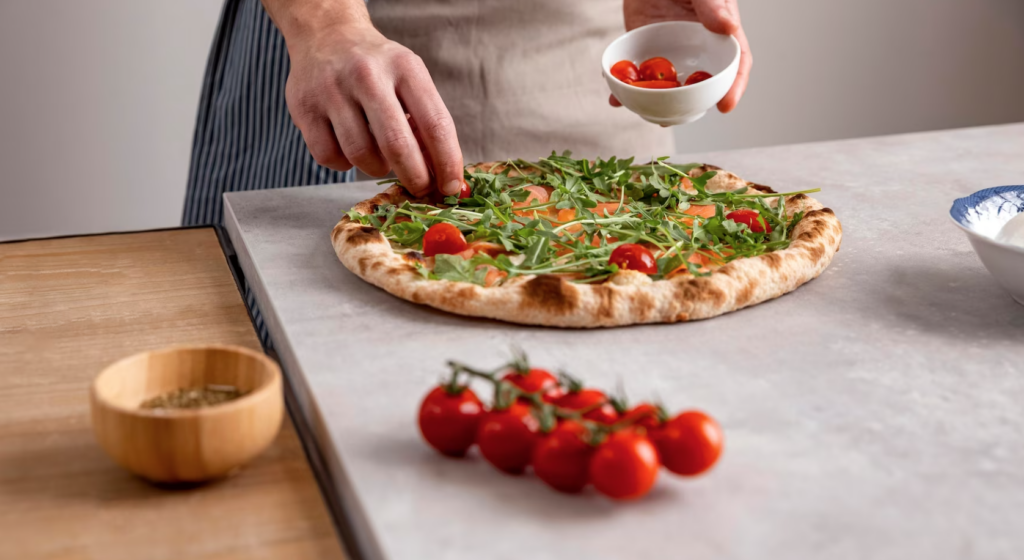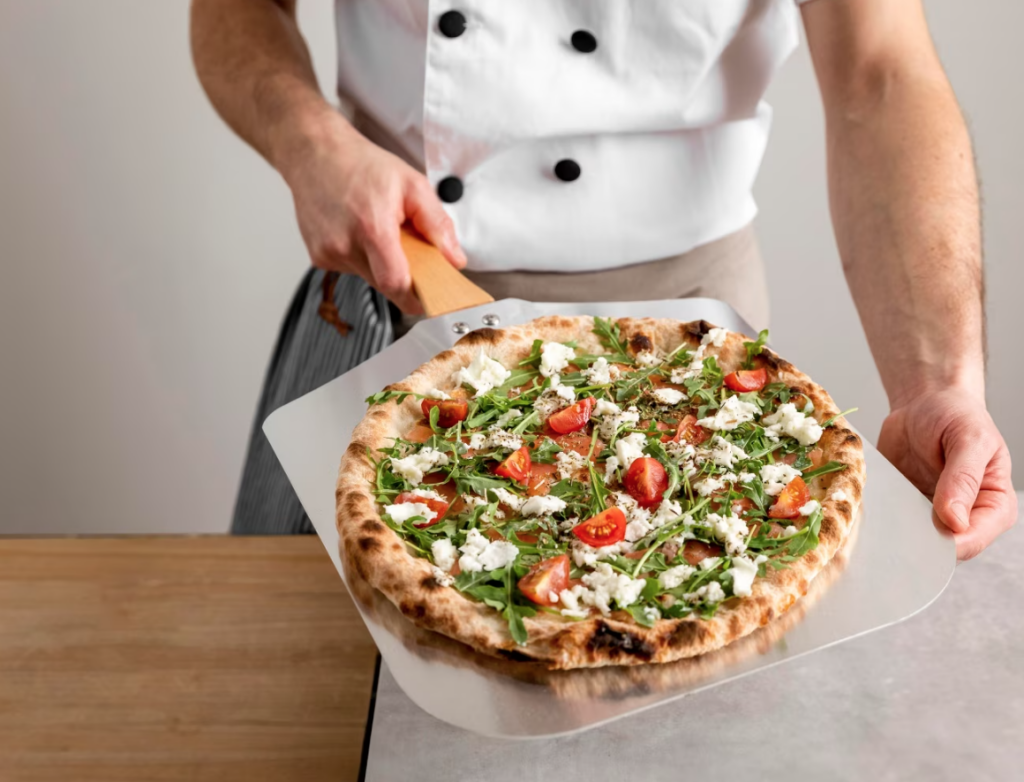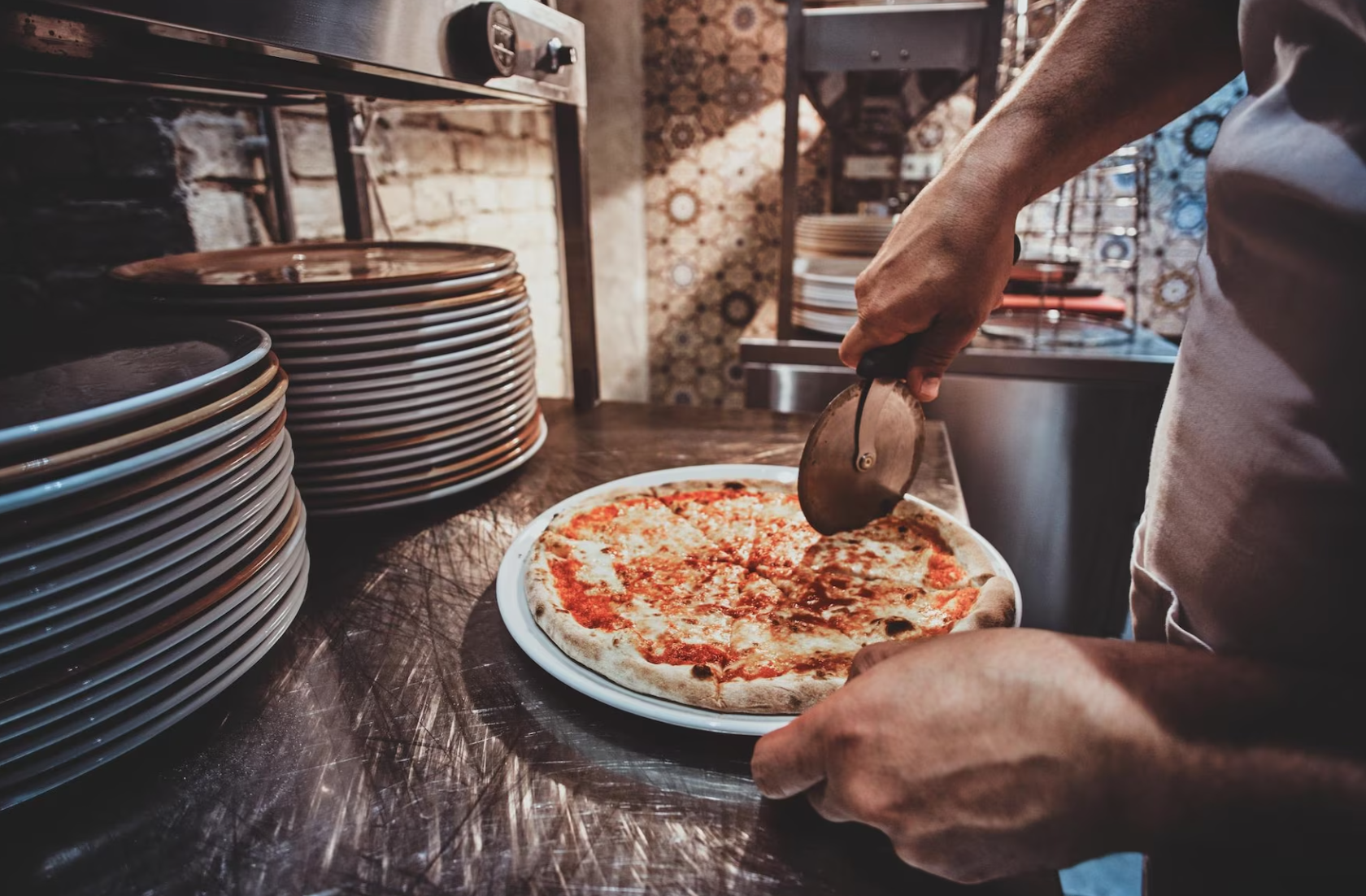Pizza – that universally beloved, irresistible symphony of flavors on a crust.
Everyone has a favorite type, and for many, there’s immense satisfaction in creating a personal pizza masterpiece at home. Ready to up your game in the kitchen?
Let’s explore the Top 10 Pizza Making Tips that promise to turn your average dough into a slice of heaven.
The Magic Begins with the Dough
Pizza making is an art, and the canvas for your culinary masterpiece is the dough. It serves as the base, determining the overall flavor and texture of your pizza.
Perfecting Your Base: Selecting the Right Flour
While many opt for all-purpose flour, experienced pizzaiolos often swear by “00” flour. It’s finely milled, lending a silky texture to your pizza base.
This flour ensures a crispy yet soft crust, perfect for classic Neapolitan pizzas. But, it’s essential to remember – the type of pizza you aim to make should guide your flour choice.
Rising to the Occasion: Yeast Matters
Yeast, the unsung hero in pizza-making, plays a pivotal role in dough fermentation. Fresh yeast, which is also called compressed or cake yeast, has a unique taste.
However, active dry yeast and instant yeast are more accessible and store longer. The key? Ensure it’s fresh and activated to ensure the perfect rise.
Sauce: The Heart of Every Pizza
A delightful sauce can make all the difference. It’s the heart, bringing together the myriad of flavors.
Homemade Vs. Store-bought: The Eternal Debate
Nothing beats the authentic flavor of a homemade sauce. Fresh tomatoes, herbs, garlic, and a touch of olive oil can create a sauce that’s miles ahead of any store-bought variant.
But for those tight on time, selecting a high-quality, low-sugar commercial sauce can also yield delectable results.
Spice It Up: Flavor Enhancements

Feeling adventurous? Elevate your sauce with additions like chili flakes, freshly ground black pepper, or even a splash of wine. Remember, balance is the key.
Choosing the Right Cheese
Cheese, with its rich, creamy texture, can elevate your pizza from mundane to marvelous. But which one should you pick?
Mozzarella: The Timeless Classic
Mozzarella is the darling of pizza enthusiasts worldwide, and for a good reason. Its milky flavor and stringy texture make it a staple for pizzas. Opt for fresh mozzarella, but remember, it has higher moisture content than the dried variety, so use it sparingly to avoid a soggy base.
Exploring Alternative Cheeses
While mozzarella reigns supreme, other cheeses like cheddar, gouda, or even feta can add a unique twist to your pizza. Mixing a couple can bring out a symphony of flavors.
Toppings: Less is More
While it’s tempting to overload your pizza with every topping you fancy, sometimes less truly is more.
Freshness is Key: Opt for Local Produce
Fresh ingredients are the secret to a standout pizza. Whether it’s bell peppers, tomatoes, or aromatic basil – always opt for the freshest produce. Local farmers’ markets can be treasure troves for high-quality ingredients.
Combining Flavors: The Art of Pairing
Some toppings are a match made in heaven – think pepperoni and jalapeños or pineapple and ham. Experiment, but remember to balance strong flavors with milder ones.
The Crucial Role of the Oven
Your oven is where the magic truly unfolds.
Conventional Vs. Stone Ovens
While traditional ovens can make delicious pizzas, stone ovens, with their higher temperatures and even heat distribution, can offer a more authentic taste and texture.
The Ideal Baking Temperature
A high temperature is crucial. Set your oven’s top temperature, which is usually between 450°F and 500°F. This ensures a crispy crust with perfectly melted cheese.
The Correct Order: Layering Techniques
Layering is an art in itself. Start with a light sauce, followed by cheese, and then add your toppings. This order ensures an even bake and prevents the crust from getting soggy.
Tools of the Trade: Must-have Equipment

Like any craft, pizza-making requires the right tools.
Pizza Stones and Steel: Which is Superior?
Pizza stones are great for even baking, but steel conducts heat faster, ensuring a quicker and crispier crust. Both have their merits, so choose based on your preference.
The Importance of a Pizza Peel
A pizza peel, apart from making you feel like a professional, helps in easy transfer of the pizza to the oven, ensuring no topping spillage.
Perfecting the Crust
The crust is more than just a base; it’s the soul of the pizza.
Thin, Thick, or Stuffed: Exploring Styles
While thin crusts offer a crunchy bite, thick crusts are doughy and filling. For those who love a surprise, stuffed crusts with cheese or even sauces can be a delightful twist.
Edge Crafting: The Ultimate Finish
A well-crafted edge, lightly brushed with olive oil or garlic butter, can provide the perfect finishing touch.
Slice it Right: Tools and Techniques
After all the effort, slicing your pizza correctly is crucial. A sharp pizza cutter ensures clean slices, preserving the visual appeal.
Serving in Style: Presentation Tips
Presentation matters. Serve on a wooden board, sprinkle some fresh herbs, and maybe pair with a glass of wine. It’s not just food; it’s an experience.
FAQs
Why is my pizza dough not crispy?
Factors like the dough’s moisture content, oven temperature, and baking duration play vital roles in achieving a crispy crust. Ensure your oven is pre-heated to the right temperature, and consider using a pizza stone for better heat distribution.
How can I prevent my pizza from becoming soggy?
Using a perforated pizza pan can help as it allows moisture to escape. Also, avoid overloading your pizza with toppings, especially those with high water content.
Which cheese melts the best on pizza?
Mozzarella is a top choice due to its excellent melting properties. However, provolone, fontina, and gouda are also fantastic options.
Should pizza dough be pre-baked?
Pre-baking, or “par-baking,” is a personal choice. It can prevent sogginess, especially if you’re using wet toppings. However, it’s not a must.
Why is “00” flour recommended for pizza?
“00” flour is highly ground and has a lot of protein, which makes it great for making a crust that is soft and chewy.
Is homemade pizza sauce better than store-bought?
Homemade sauce allows for customization and typically lacks preservatives, offering a fresher taste. But, quality store-bought sauces can be equally delightful when chosen carefully.
Conclusion
Pizza making is a delightful journey, blending art and science. Whether you’re a seasoned chef or a home cook eager to experiment, these Top 10 Pizza Making Tips are your passport to achieving pizzeria-worthy results in your kitchen. Embrace the process, learn from every pie, and most importantly, enjoy every bite!



